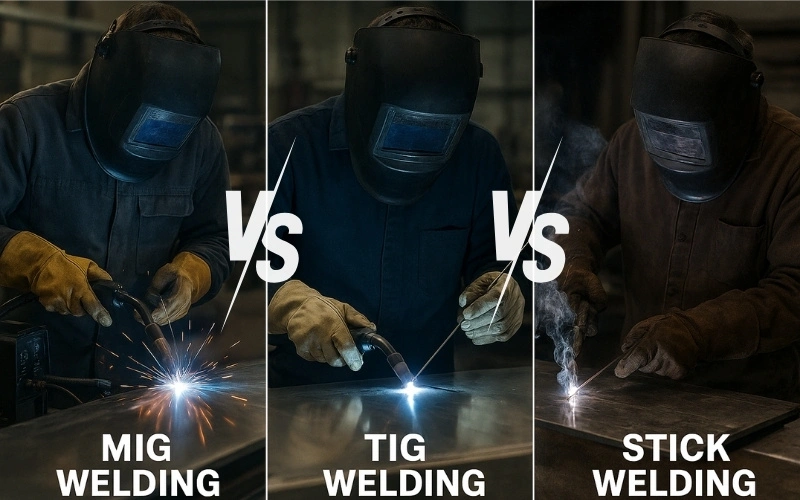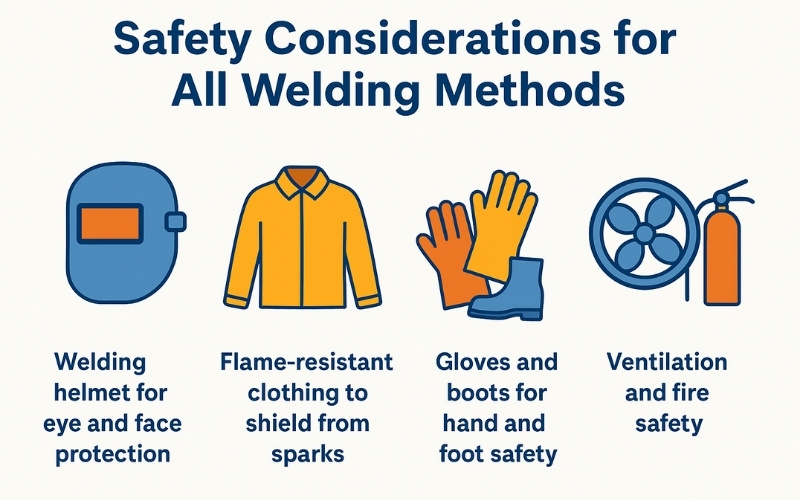Choosing the right welding method can make or break a project. Whether you’re a beginner setting up your first workshop or a professional tackling heavy-duty structural work, the decision between MIG, TIG, and Stick welding shapes your results, cost, and efficiency. Each process has unique strengths and trade-offs, and understanding them is the key to welding smarter, not harder. In this guide, we will compare MIG, TIG, and Stick welding in detail, explain their pros and cons, and help you decide which is best for your specific needs.
What are MIG, TIG and Stick Welding?
Before comparing, it’s important to clearly understand how each process works.
MIG Welding
MIG welding, or Gas Metal Arc Welding (GMAW), is often called the “hot glue gun” of the welding world, and for good reason. It’s an incredibly fast and efficient process that’s the easiest to learn, making it wildly popular among beginners, home hobbyists, and in production manufacturing settings. This method has some advantages:
- High welding speeds are ideal for large projects.
- Cleaner processes with minimal spatter.
- Adaptable to various materials and thicknesses.
However, it also has some limitations:
- Less effective on thick materials without advanced equipment.
- Requires a clean, uncontaminated surface for optimal results.
- Equipment can be more expensive compared to other methods.
TIG Welding
TIG welding, or Tungsten Inert Gas welding, uses a non-consumable tungsten electrode. It’s known for precision and control. It applies an arc between the electrode and the workpiece. A separate filler rod is optional, used for joining pieces. This method suits materials requiring precision, such as thin metals. Its detailed approach is useful in fields like aerospace and art. Key advantages of TIG welding:
- Works on a range of metals, including aluminum.
- Produces aesthetically appealing weld beads.
- Provides superior control over heat and the weld pool.
Despite its advantages, TIG welding has some drawbacks:
- Higher skill level and training required.
- Slow process, not ideal for time-sensitive jobs.
- It can be costly due to equipment and consumables.
Stick Welding
Stick welding, or Shielded Metal Arc Welding (SMAW), is highly versatile. It’s often used outdoors and on rough surfaces. This method employs a consumable electrode coated in flux. The flux protects the weld by creating a gas shield when melted. An electric current generates an arc between the electrode and the metal. This arc melts both the rod and the workpiece, joining them. Stick welding doesn’t require shielding gas, making it ideal for remote or windy environments. Some benefits of this technique:
- Effective on various materials, including thicker metals.
- Does not need gas, making it useful for outdoor work.
- Lower initial equipment costs make it budget-friendly.
Similar to the other two methods, stick welding also includes some disadvantages:
- Creates more post-welding cleanup with slag.
- Less precision compared to TIG, it can be rough.
- More difficult to use on delicate, thin materials.

MIG vs TIG vs Stick Welding: Side-by-Side Comparison
Choosing between MIG, TIG, and Stick welding involves considering your project’s needs and material types. Each method offers specific strengths and weaknesses.
- MIG welding is known for its speed and efficiency. It’s ideal for projects that require quick turnaround and less intricate detail. Its ease of use makes it popular among beginners.
- TIG welding stands out for precision and clean welds. It is best for detailed work on thin materials. While it requires skill, the results are aesthetically pleasing and consistent.
- Stick welding shines in outdoor and heavy-duty applications. It’s perfect where conditions are challenging, such as for structural repairs. Its versatility on dirty and thick metals adds to its appeal.
Here are some comparative points to consider:
Key Advantages:
- MIG: Fast, efficient, great for beginners.
- TIG: Precision, high-quality finishes.
- Stick: Versatile, no need for gas.
Key Considerations:
- MIG: Needs clean surfaces and is wind-sensitive.
- TIG: Slower, requires more skill.
- Stick: May require more cleanup, less precise.
Knowing these differences helps in selecting the most suitable welding method for your projects.
Which Welding Method Should You Use?
Selecting the right welding method depends on your specific project requirements. Consider the type of material, required precision, and environment. Each technique offers unique benefits tailored to different needs.
For beginners and hobbyists, MIG welding is often recommended. Its ease of use and speed make it suitable for home projects. For tasks demanding precision and immaculate welds, TIG welding is preferable. It excels with intricate designs and thin materials.
In demanding environments, such as outdoors or with dirty metals, Stick welding is unmatched. It’s robust and versatile across a range of conditions. Weighing your project’s demands against these strengths helps in making an informed choice. When deciding, keep these factors in mind:
- Material Type and Thickness
- Location of Work (Indoor/Outdoor)
- Required Precision and Finish
Safety Considerations for All Welding Methods
Safety is crucial in welding to prevent injuries. All methods emit intense heat and UV radiation, posing risks without precautions. Proper gear is essential to protect against burns and radiation. Always wear protective equipment, including:
- Welding helmet for eye and face protection
- Flame-resistant clothing to shield from sparks
- Gloves and boots for hand and foot safety
A well-ventilated area minimizes inhalation of harmful fumes. Keep a fire extinguisher nearby for emergencies. Adhering to safety standards ensures a safer welding environment for everyone involved.

Conclusion
In conclusion, choosing between MIG, TIG, and Stick welding depends on your project’s needs. Each method offers unique benefits and challenges that suit different situations. Evaluate your material type, project environment, and required precision. Consider your skill level and available equipment. By understanding these factors, you can select the most effective welding method, ensuring success in your welding endeavors.
FAQs
When performed correctly by a skilled operator, a TIG weld is generally considered the strongest and purest due to the level of control and cleanliness involved. However, all processes can create welds that are stronger than the base metal itself if done properly.
MIG will be an ideal choice. It’s trigger‑controlled and forgiving. The stick is portable and cheap, but requires arc control practice. TIG has the steepest learning curve.
TIG generally produces the least. MIG and especially Stick can produce significant fumes – ventilation and respirators are important.
